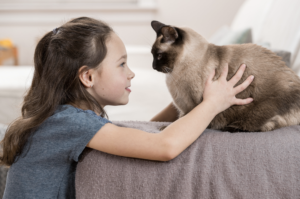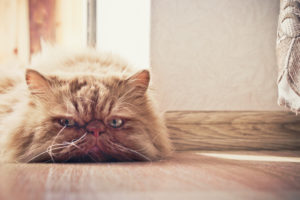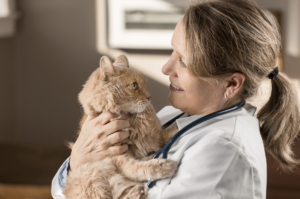 Many of our feline friends suffer from Feline Idiopathic Cystitis (FIC), a non-bacterial and often recurrent inflammation of the bladder. Cystitis is the most common type of Feline Lower Urinary Tract Disease (FLUTD), a disease that accounts for at least three to five percent of feline patients brought into veterinary clinics. The causes of cystitis are not completely understood, although studies suggest that it is most closely linked to stress. The most common symptoms of cystitis include painful, infrequent, or excessive urination. In order to relieve our cats of the pain and stress that surround this condition, we must begin by investigating the connection between cystitis and inflammation.
Many of our feline friends suffer from Feline Idiopathic Cystitis (FIC), a non-bacterial and often recurrent inflammation of the bladder. Cystitis is the most common type of Feline Lower Urinary Tract Disease (FLUTD), a disease that accounts for at least three to five percent of feline patients brought into veterinary clinics. The causes of cystitis are not completely understood, although studies suggest that it is most closely linked to stress. The most common symptoms of cystitis include painful, infrequent, or excessive urination. In order to relieve our cats of the pain and stress that surround this condition, we must begin by investigating the connection between cystitis and inflammation.
Contents
Is My Cat At-Risk of Developing Cystitis?
What Causes Cystitis in Cats?
Cystitis will manifest uniquely depending on your cat’s personality, biology, and environment. In fact, the causes of interstitial cystitis in women mirror the causes of FIC! So, when trying to determine which internal and external factors caused your cat to develop cystitis, the first step is to observe your cat in all their complexity—as you would a human. Always remember to ask your vet for advice, as cat behavior is tricky to interpret.
Stress, Inflammation, and Feline Cystitis
Stress and inflammation are at the core of what we know about cystitis thus far. Dr. Tony Buffington of Ohio State University’s College of Veterinary Medicine comments, “control and predictability are as important to cats as they are to us.” If your cat does not feel in control or is in an unpredictable environment, levels of cortisol will skyrocket, causing them to experience stress and inflammation.
There are several types of stressors that can trigger cystitis in your cat:
| Stressor Type | Examples |
| Emotional |
|
| Environmental |
|
| Nutritional |
|
| Biological |
|
Is My Cat At-Risk of Developing Cystitis?
 It is important to keep in mind that it is not just a genetic predisposition that causes medical conditions like cystitis, but the combination of “the genetic setup…and this pressure cooker effect of life,” as Dr. Nicholas Dodman so wisely states, that “triggers” a disease. Cats that suffer from other medical complications, especially diabetes, are particularly prone to developing cystitis. Most research and clinical trials have not found a correlation between breed and risk of FIC.
It is important to keep in mind that it is not just a genetic predisposition that causes medical conditions like cystitis, but the combination of “the genetic setup…and this pressure cooker effect of life,” as Dr. Nicholas Dodman so wisely states, that “triggers” a disease. Cats that suffer from other medical complications, especially diabetes, are particularly prone to developing cystitis. Most research and clinical trials have not found a correlation between breed and risk of FIC.
Other factors that might make your cat more at-risk include:
- Health and Exercise: overweight cats with little opportunity to exercise.
- Age: About 70% of FLUTD patients under the age of ten suffer from cystitis. Only about 5% of cats over the age of ten develop cystitis, though they are more likely to develop urinary tract infections.
- Sex: female cats usually suffer from non-obstructive FIC, while male cats are particularly at-risk of developing obstructive FIC—a blockage of the urethra that causes an inability to urinate and requires immediate medical attention.
Feline Cystitis Symptoms
Every cat has their own coping mechanisms; any change to your cat’s temperament or their routine might indicate that they are under stress or in pain. The Feline Musculoskeletal Pain Index is a great resource that can help break down behaviors that may appear normal to us but may actually indicate that our cats are in pain.
Personality and Routine Changes
Something as simple as your cat slipping under the bed frequently or not spending as much time in their favorite spot may not seem worrisome to you, but these tiny changes are often the only signs of weakness cats are willing to show. Even moodiness might seem normal—especially coming from a cat—but could indicate that your cat is in pain.
Common Behavioral Changes in Cats With Cystitis:
 Hiding somewhere safe
Hiding somewhere safe- Avoiding socialization
- Abnormal neediness or nervousness
- Overreacting to environment
- Excessive meowing
- Eating less
- Urinating outside of the litter box
Common Physical Changes in Cats With Cystitis:
- Stops grooming
- Over-grooming, especially in the perineal region
- Inability to urinate/passing less urine
If your cat cannot urinate, or screams while urinating, go to the vet immediately!
Although FIC is an extremely common condition that can resolve itself, it is often a chronic disease; 40-50% of cats will experience a recurring episode within a year. So, even if your cat’s symptoms resolve on their own, it is essential to take preventative measures in order to minimize the chance of a flare-up.
Feline Cystitis Diagnosis
If you think your cat has cystitis, the first step is to bring them to the veterinarian for a physical examination and testing. Screening lab tests such as urine analysis are particularly important because they will provide your vet insight into your cat’s health.
Cystitis Treatments for Cats
Since cystitis does not involve an infection, antibiotics usually do not help. Instead, your vet may suggest one of—or a combination of—the treatments outlined below.
In-Office Feline Cystitis Treatments
 For cats that have obstructive FIC, an in-office appointment is essential. Your vet will likely use a catheter if they need to remove an obstruction (most commonly urinary stones or urethral plugs). Laser therapy is also a common in-office treatment that has been found to help reduce pain and inflammation in cystitis patients.
For cats that have obstructive FIC, an in-office appointment is essential. Your vet will likely use a catheter if they need to remove an obstruction (most commonly urinary stones or urethral plugs). Laser therapy is also a common in-office treatment that has been found to help reduce pain and inflammation in cystitis patients.
Medications for Cystitis in Cats
Your vet may prescribe medications in order to treat your cat’s cystitis, though it is not easy to trick most cats into swallowing a pill or staying still for an injection. Many cats are also sensitive to a certain class of medications called non-steroidal anti-inflammatory drugs (NSAIDs), none of which are FDA-approved for long term use in cats. Some common medications used to treat cystitis include:
- Steroids have helped some patients suffering from obstructive FIC or urethral damage
- Muscle relaxants can help minimize urethral spasms
- Anti-emetic medications such as Cerenia
- Nonsteroidal anti-inflammatory drugs (NSAIDs) such as Robenacoxib & Meloxicam
- Combination of acepromazine (sedative & anti-nausea drug) and buprenorphine (opioid)
Treating Cystitis with Multimodal Environmental Modification
A clinical trial published in the Veterinary Clinics of North America concluded that, for acute cystitis, the best treatments involve improving your pet’s nutrition and implementing environmental enrichment strategies in order to minimize your pet’s stress level. Multimodal Environmental Modification (MEMO), a comprehensive form of environmental enrichment, has been proven to be particularly beneficial for FIC patients. MEMO involves careful observation of your cat’s behavior and modification of anything—from nutrition to litter box cleanliness—that seems to be causing your cat stress. The American Association of Feline Practitioners lists five pillars of environmental enrichment they believe cats require.
Nutritional Modifications
Not only can proper diet help your cat recover from cystitis, but it can also prevent the condition in the first place. The most important nutritional improvement you can make is introducing more water into your cat’s diet, perhaps in part by switching over to canned food, which is about 70% water. If your cat drinks more water, their bladder will stretch and allow chemicals to drain out quicker, therefore reducing inflammation. Your vet can be a great resource to help you come up with a diet specifically tailored to your cat’s unique needs.
Here are some dietary tips to help you get started:
- Healthier cat food: The Ohio State University College of Veterinary Medicine’s pet diet information center can help you choose which type of food is best for your cat.
- More opportunities to drink water: add more water bowls throughout your house.
- Herbal remedies and antioxidants: herbs including slippery elm bark and cornsilk as well as antioxidants such as cranberry extract may be prescribed by your veterinarian.
- Supplements: glycosaminoglycan supplements have proved beneficial in some cases.
Environmental Modifications
In order to reduce your cat’s stress, it is vital that you make sure they have all their basic needs met, just like they would have it in the wild. Dr. Tony Buffington raves that environmental enrichment “can reduce IC cats’ syndrome burden by about 75 or 80 percent.”
Alterations to Common Environmental Stressors:
| Environmental Stressor | Solution | Notes & Tips |
| Multi-cat household | Each cat should have at least one water source, one food source, and one litter box all to themselves. | Cats always need to be able to remove themselves from social situations! |
| Small or messy litter box, or litter box in a bad location | Every cat is picky in their own way, so observe your cat and make necessary changes. | Don’t make changes arbitrarily—give your cat choices. |
| Over or under-socialization | Observe your cat and try to provide them with the right amount of socialization for their unique personality. | Both constantly being surrounded by people/animals and being alone for a long time can make cats unhappy. |
| A noisy neighborhood | Treatments such as behavior modification and desensitization may help. | Make sure your cat has space to hide, perhaps in the quietest room of the house. |
| Sudden change (relocation, introduction of new pet, etc.) | Set up space for your cat that is all their own—where they can feel safe. | Check out these tips on how to help your cat adjust to new family members or to a new environment. |
| Unpredictable routines | Maintain as much consistency as possible. | Try to make sure you are feeding your cat at the same time every day. |
Some veterinarians also recommend using pheromones such as Feliway in conjunction with your environmental enrichment plan as a way to reduce some of your cat’s stress behaviors. For more inspiration on how to enrich your cat’s environment, check out these home makeover suggestions from the Humane Society.
What Not to Do: A Note on Punishment
One of the most common symptoms of cystitis—urinating outside the litter box—naturally makes cat owners very frustrated. As a result, one may be tempted to punish cats for this behavior. Unfortunately, cats don’t understand the objective of punishments. If your cat is having litter box issues due to a cystitis flare-up, getting angry at your cat will only exacerbate their symptoms. Instead, start with a trip to the vet—just in case there’s something serious going on.
The Assisi Loop as a Safe, At-Home Treatment for Feline Cystitis
The Assisi Loop is an FDA-approved non-pharmaceutical anti-inflammatory device (NPAID) that provides cystitis relief in the comfort of your own home, eliminating the complications that often surround administering feline treatments. Assisi’s proprietary technology has been proven to considerably reduce inflammation and even eliminate pain. If your cat is prone to cystitis flare-ups, the Loop can also help prevent or minimize the severity of future FIC episodes. Dr. Stephanie Medcroft comments, “Because [the Loop] reduces inflammation, I started using it with cats who had pancreatitis and early stages of cystitis…This year I think I warded off an impending [cystitis] blockage with the Assisi Loop.”
an FDA-approved non-pharmaceutical anti-inflammatory device (NPAID) that provides cystitis relief in the comfort of your own home, eliminating the complications that often surround administering feline treatments. Assisi’s proprietary technology has been proven to considerably reduce inflammation and even eliminate pain. If your cat is prone to cystitis flare-ups, the Loop can also help prevent or minimize the severity of future FIC episodes. Dr. Stephanie Medcroft comments, “Because [the Loop] reduces inflammation, I started using it with cats who had pancreatitis and early stages of cystitis…This year I think I warded off an impending [cystitis] blockage with the Assisi Loop.”
Although our feline friends are extremely susceptible to inflammation, there is a surprising lack of safe and effective treatments available to help them. This makes the Loop all the more important, as it is an anti-inflammatory therapy with virtually no side effects or risks. The Loop is non-invasive and only needs to be placed near or on the site of inflammation. This therapy is particularly suited to a cat’s disposition because it can help reduce inflammation without even registering as an intrusion in your cat’s mind—and has the added benefit of avoiding “pilling.”
As a stand-alone treatment, Assisi has seen the Loop improve internal inflammatory problems such as pancreatitis and cystitis in just 24 hours. As a multimodal therapy, you can add the Loop to your vet-approved treatment plan without worrying about drug interactions or other complications.
Countless cats have joined the circle of care in order to relieve FIC-related symptoms. Cleo is one of the many cats who have found relief by adding the Loop to her multimodal treatment plan. You can read all about Cleo’s journey here.
If you want to learn more about the technology behind The Assisi Loop, check out our list of approved providers to find a vet near you!
Learn More About the Assisi Loop!
DISCLAIMER: Assisi Animal Health does not intend to provide medical advice. The information provided in this piece is for educational purposes only.
